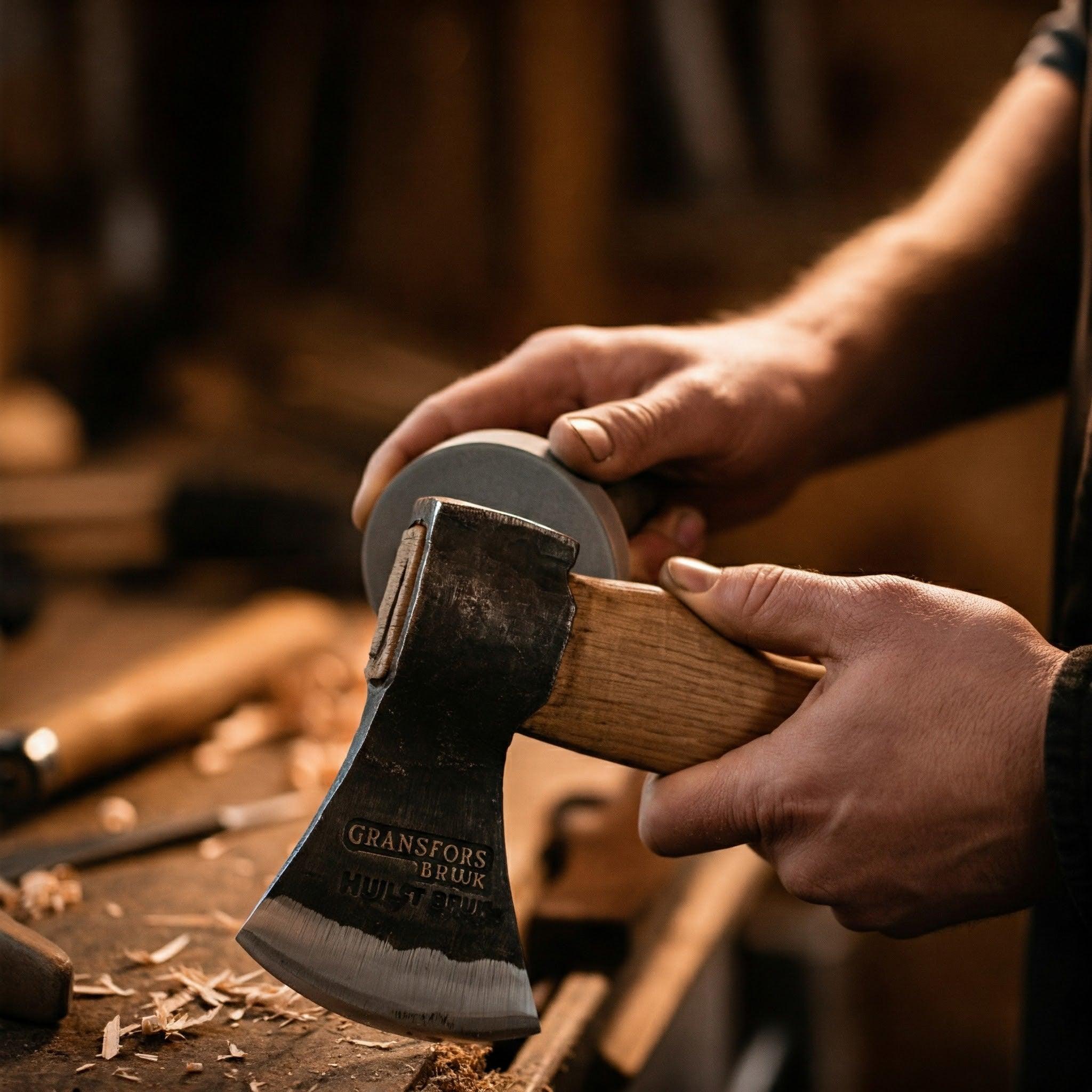A well-honed Axe is a thing of beauty and a testament to the craft of the woodsman. Whether you're felling a mighty oak or splitting kindling for the fire, a sharp edge is essential for efficiency and safety. This is especially true when you wield a hand-forged masterpiece like a Gransfors Bruk or Hults Bruk axe. These axes are crafted with meticulous care, and their edges deserve the same respect. But fear not, sharpening these beauties is a skill within anyone's reach.
This guide will walk you through the process of sharpening your hand-forged axe, focusing on techniques using a sharpening puck or stone. We'll also delve into the age-old debate of water vs. oil and offer some tips to help you achieve a razor-sharp edge.
Why Sharpening Matters:
A Sharp Axe:
- Cuts Cleaner: Slices through wood fibers effortlessly, reducing the effort required.
- Is Safer: A dull axe is more likely to glance off the wood, increasing the risk of injury.
- Preserves the Axe: Proper sharpening maintains the correct bevel angle and prevents damage to the blade.
Tools of the Trade:
- Sharpening Puck or Stone: These come in various grits. A double-sided puck with a coarse and fine grit is ideal for axe sharpening. Look for round or oval shapes designed for axes.
- Water or Oil: Used as a lubricant to keep the stone clean and prevent overheating the axe blade.
- Leather Strop (Optional): For the final polishing and removing any burr.
- Gloves: Protect your hands during the process.
- A Sturdy Surface: A workbench or a solid log to secure the axe head.
Water vs. Oil: The Great Debate:
Both water and honing oil have their proponents:
-
Water Stones:
- Pros: Readily available, less messy, easier cleanup.
- Cons: Some water stones require soaking before use. They may also wear down faster than oil stones.
-
Oil Stones:
- Pros: Sharpen effectively and don't require soaking. Generally more durable.
- Cons: Can be messier, oil needs to be reapplied regularly.
Note: For Axes, especially finer ones like Gransfors Bruk and Hults Bruk, either water or a fine honing oil works well. We prefer Water as a great starting point due to its convenience.
Sharpening Your Axe Step-by-Step:
- Assess the Edge: Examine the axe head for any nicks, chips, or dullness. This will determine how much work is needed.
- Secure the Axe: Clamp the axe head securely to a workbench or use a vise if available. If working outdoors, rest the head on a sturdy log. Position it so you can comfortably work on the entire bevel.
- Lubricate the Stone: If using a water stone, soak it for the recommended time (or just apply water to the surface). If using an oil stone, apply a thin layer of honing oil.
- Start with the Coarse Grit: Hold the puck or stone flat against the bevel angle of the axe head. The bevel on a Gransfors or Hults Bruk is typically a Scandinavian grind, a fairly wide, flat bevel.
- Circular Motions: Using firm, even pressure, move the stone in small circular motions along the edge. Work from the heel (closest to the handle) to the toe (the tip) of the blade. Key is to keep a uniform circular motion when going round-and-round.
- Maintain the Angle: It's crucial to maintain the original bevel angle. Imagine you're trying to lay the stone flat against the bevel, not grinding a new angle.
- Check for a Burr: As you sharpen, a slight burr (a raised edge) will form on the opposite side of the blade. This is a good sign; it means you're removing metal.
- Flip and Repeat: Once you've worked the entire edge on one side and felt the burr, flip the axe and repeat the process on the other side.
- Switch to Fine Grit: After establishing a consistent bevel with the coarse grit, switch to the fine grit side of your puck or stone. Repeat the circular motions, focusing on polishing the edge and removing the burr.
- Stropping (Optional): For a truly razor-sharp edge, use a leather strop. Apply a bit of stropping compound if desired, and draw the blade along the strop away from the edge, flipping it over after each pass.

Recommendations and Tips for Gransfors Bruk and Hults Bruk Axes:
- Respect the Steel: These axes are made from high-quality steel. Use a good quality sharpening stone to avoid damaging the edge.
- Don't Overheat: Take breaks if necessary to prevent the blade from overheating, which can affect the temper of the steel.
- Practice Makes Perfect: Sharpening is a skill that improves with practice. Don't be discouraged if your first few attempts aren't perfect.
- File First (If Needed): If your axe has significant chips or damage, use a mill file to reshape the edge before moving to the sharpening stone.
- Watch Videos: There are excellent online videos demonstrating axe sharpening techniques. Watching a visual demonstration can be very helpful.
- Gransfors Bruk Axe Book: If you own a Gransfors Bruk, the accompanying "Axe Book" provides valuable information on care and sharpening.
- Lansky Puck: A popular choice for a good all-around axe sharpening stone.
- Fallkniven DC4: A great option for a whetstone that uses water.
Conclusion:
Sharpening your hand-forged axe is a rewarding experience that connects you with the tool and the craft of woodworking. By following these steps and using the right tools, you can keep your Gransfors Bruk, Hults Bruk, or any other quality axe in prime condition, ready for any task. So, embrace the art of the edge, and enjoy the satisfaction of a well-maintained axe.
Check Out our Premium Axes from Gransfors Bruk Axes and Hults Bruk Axes






Share:
What is a Sloyd Knife?